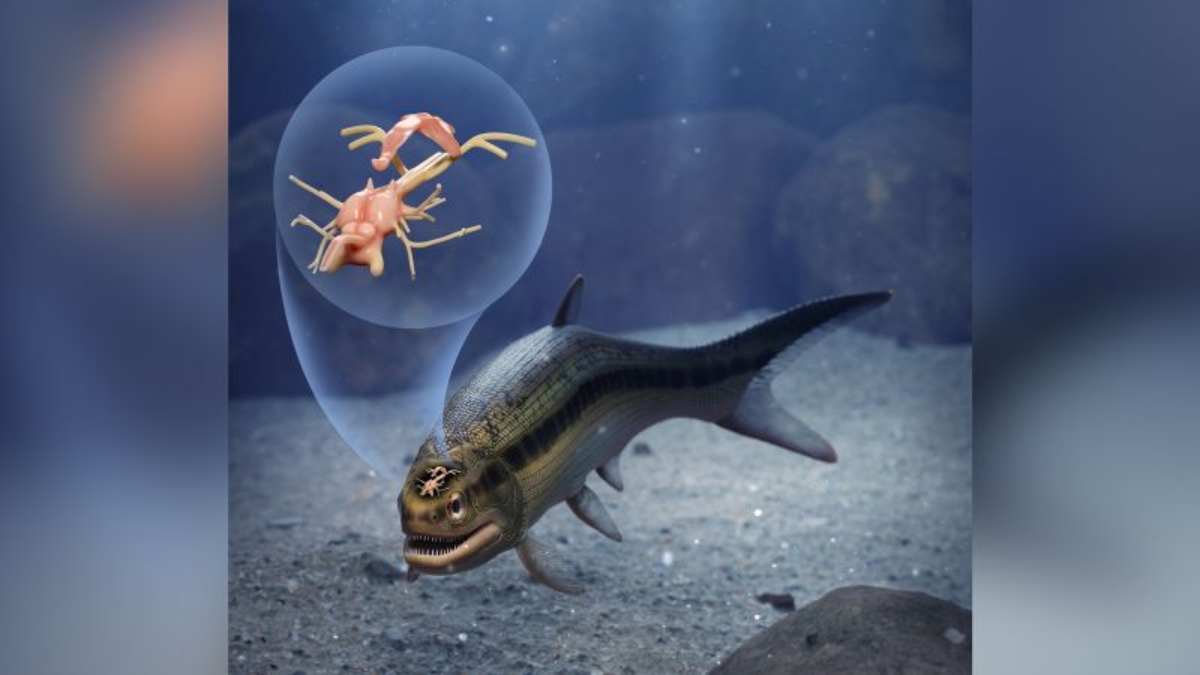An artist's rendering of the 319 million-year-old extinct ray-finned Conocephalus wildi, believed to have been 6 to 8 inches long and carnivorous.
(Credit: Márcio L. Castro)
(CNN) --
A CT scan of a 319-million-year-old fossilized fish skull has led to the discovery of the oldest specimen of a well-preserved vertebrate brain, shedding new information on the early evolution of bony fish.
The fossil skull belonging to the extinct Coccocephalus wildi was found in a coal mine in England more than a century ago, according to the researchers in the study published Wednesday in the journal
Nature
.
The fossil is the only known specimen of the fish species, so scientists from the University of Michigan in the US and the University of Birmingham in the UK used the non-destructive imaging technique of computed tomography (CT) to look inside your skull and examine your inner body structure.
In doing so, a surprise came.
The CT image showed an "unidentified blob," according to a University of Michigan news release.
The distinct 3D object had a clearly defined structure with features found in vertebrate brains: it was bilaterally symmetrical, contained hollow spaces similar in appearance to ventricles, and had filaments that extended and resembled cranial nerves.
advertising
A CT scan of the fish's fossilized skull was found to have a well-preserved brain inside.
(Credit: Jeremy Marble/University of Michigan News)
"This is such an exciting and unexpected find," study co-author Sam Giles, a vertebrate paleontologist and principal investigator at the University of Birmingham, told CNN on Thursday, adding that they had "no idea" there was a brain inside when they decided to study the skull.
“It was so unexpected that it took us a while to be sure that it was actually a brain.
Besides being just a conservation curiosity, the anatomy of the brain in this fossil has big implications for our understanding of brain evolution in fish,” he added.
Fills "important gaps" in knowledge
C. wildi was an early ray-finned fish — possessing a backbone and fins supported by bony rods called "rays" — thought to have been 6 to 8 inches long, swam in an estuary, and ate small animals and aquatic insects, according to the researchers.
The brains of living ray-finned fish display structural features not seen in other vertebrates, most notably a forebrain consisting of neural tissue that folds outward, according to the study.
In other vertebrates, this neural tissue folds inward.
C. wildi lacks this distinctive feature of ray-finned fish, with the configuration of a part of its forebrain called the "telencephalon" more closely resembling that of other vertebrates, including amphibians, birds, reptiles and mammals, according to researchers. study authors.
The brain structure of the forebrain of C. wildi resembles that of other vertebrates more than that of other ray-finned fish, the study authors said.
(Credit: Figueroa et al. in Nature)
"This indicates that the telencephalon configuration seen in living ray-finned fish must have arisen much later than previously thought," said study lead author Rodrigo Tinoco Figueroa, a doctoral student at the Museum of Paleontology. from the University of Michigan.
He added that "our knowledge about the evolution of the vertebrate brain is mostly limited to what we know from living species," but "this fossil helps us fill important gaps in knowledge that could only be obtained from rare fossils like this one." .
brain preservation
Unlike hard bones and teeth, scientists rarely find brain tissue, which is soft, preserved in vertebrate fossils, according to the researchers.
However, the study noted that the C. wildi brain was "exceptionally" well preserved.
While invertebrate brains have been found up to 500 million years old, they are all flattened, Giles said, adding that this vertebrate brain is "the oldest three-dimensional fossil brain we know of."
'Fish Lizard' Fossils Found in the Swiss Alps Belong to Some of the Largest Creatures That Ever Lived
The skull was found in layers of soapstone.
Low oxygen concentration, rapid burial by fine-grained sediment, and a very compact and protective braincase played a key role in preserving the fish's brains, according to Figueroa.
The braincase created a chemical microenvironment around the closed brain that could have helped replace its soft tissue with a dense mineral that maintained the fine details of the brain's 3D structures.
Giles said: "The next steps are to figure out exactly how such delicate features like the brain can be preserved for hundreds of millions of years, and to search for more fossils that also preserve the brain."
BrainSkullFossils



/cloudfront-eu-central-1.images.arcpublishing.com/prisa/65WJB3EG45EZDLAF5QNRLPUDDU.jpg)





